The Pulmonary Heart Valve Replacement Market is estimated to be valued at USD 1.6 billion in 2025 and is projected to reach USD 3.9 billion by 2035, registering a compound annual growth rate (CAGR) of 9.1% over the forecast period.
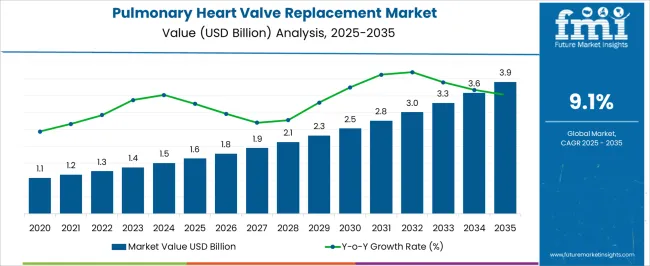
| Metric | Value |
|---|---|
| Pulmonary Heart Valve Replacement Market Estimated Value in (2025 E) | USD 1.6 billion |
| Pulmonary Heart Valve Replacement Market Forecast Value in (2035 F) | USD 3.9 billion |
| Forecast CAGR (2025 to 2035) | 9.1% |
The Pulmonary Heart Valve Replacement market is experiencing robust growth driven by increasing prevalence of congenital heart defects, pulmonary valve stenosis, and other cardiovascular diseases affecting the pulmonary valve. The demand for minimally invasive and durable valve replacement solutions is rising as surgical techniques evolve and post-operative outcomes improve. In 2025, the market is witnessing heightened adoption of advanced valve technologies due to improvements in biocompatibility, reduced procedural complications, and enhanced long-term durability.
Increasing healthcare infrastructure investment, particularly in tertiary care centers and specialized cardiac hospitals, is further supporting market expansion. The rising awareness of early detection and intervention for pulmonary valve disorders has led to higher diagnosis rates and procedural uptake.
Technological advancements such as transcatheter pulmonary valve replacement and next-generation imaging integration are enabling precise placement and patient-specific customization As healthcare providers continue to prioritize patient safety, clinical outcomes, and cost efficiency, the Pulmonary Heart Valve Replacement market is expected to maintain steady growth, offering opportunities for manufacturers to expand their presence in both established and emerging healthcare markets.
The pulmonary heart valve replacement market is segmented by valve type, application type, end user, and geographic regions. By valve type, pulmonary heart valve replacement market is divided into Biological Valve and Mechanical Valve. In terms of application type, pulmonary heart valve replacement market is classified into Pulmonary Valve Stenosis, Pulmonary Atresia, Pulmonary Valve Regurgitation, and Others. Based on end user, pulmonary heart valve replacement market is segmented into Hospitals, Ambulatory Surgical Centers, Clinics, and Others. Regionally, the pulmonary heart valve replacement industry is classified into North America, Latin America, Western Europe, Eastern Europe, Balkan & Baltic Countries, Russia & Belarus, Central Asia, East Asia, South Asia & Pacific, and the Middle East & Africa.
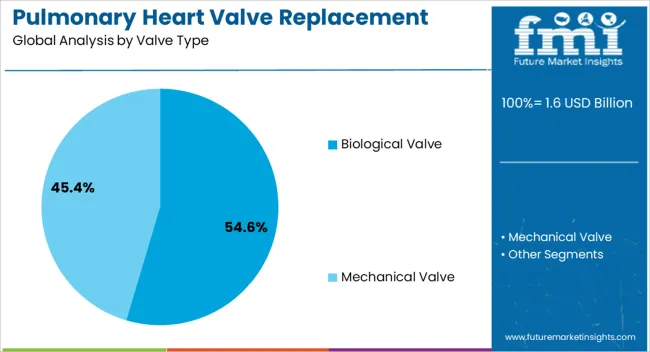
The Biological Valve segment is projected to hold 54.60% of the Pulmonary Heart Valve Replacement market revenue in 2025, positioning it as the leading valve type. This dominance is attributed to the superior biocompatibility and reduced thrombogenic risk offered by biological valves compared to mechanical alternatives. Adoption has been accelerated by advancements in tissue engineering and preservation techniques, which improve durability and reduce degeneration rates.
Biological valves are preferred for their ability to eliminate the need for long-term anticoagulation therapy, making them particularly suitable for patients with contraindications or higher bleeding risk. Widespread clinical acceptance and favorable long-term outcomes have reinforced confidence among surgeons and cardiologists, driving demand in both adult and pediatric populations.
Additionally, the adaptability of biological valves to minimally invasive procedures has strengthened their market position The growth of this segment is further supported by the expansion of specialized cardiac centers, increasing procedural volumes, and the rising prevalence of valvular disorders requiring replacement.
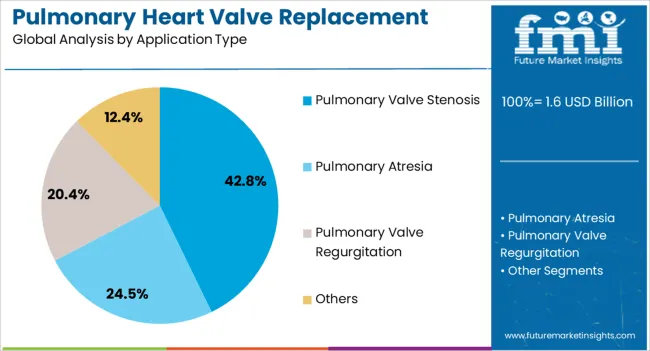
The Pulmonary Valve Stenosis application segment is expected to account for 42.80% of the Pulmonary Heart Valve Replacement market revenue in 2025, making it the leading application. This prominence is being driven by the widespread occurrence of congenital pulmonary valve narrowing and acquired stenosis conditions. The increased adoption of pulmonary valve replacement procedures is being influenced by improvements in early diagnosis through echocardiography and imaging modalities, which enable timely intervention.
The segment has benefited from the availability of advanced surgical techniques and transcatheter approaches that reduce operative risk and enhance recovery times. Demand is further bolstered by the long-term efficacy of valve replacement in restoring hemodynamic stability and preventing right ventricular dysfunction.
Patient outcomes, including quality of life and reduced hospitalization, have solidified the preference for procedural intervention in cases of significant stenosis As awareness of pulmonary valve disorders continues to rise and more patients gain access to specialized cardiac care, the Pulmonary Valve Stenosis segment is anticipated to maintain its leadership in terms of market share.
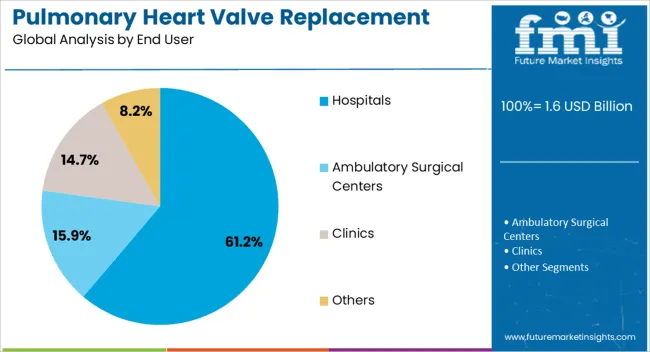
The Hospitals end-user segment is anticipated to hold 61.20% of the Pulmonary Heart Valve Replacement market revenue in 2025, emerging as the largest end-use segment. This leadership is being driven by the concentration of advanced cardiac surgical capabilities, post-operative care facilities, and intensive monitoring infrastructure in hospitals. Adoption is further facilitated by the availability of specialized cardiac surgeons, trained interventional cardiologists, and support staff capable of handling complex valve replacement procedures.
Hospitals offer integrated platforms that combine diagnostic imaging, intraoperative guidance, and post-surgical rehabilitation, ensuring superior patient outcomes. High procedural volumes, supported by referral networks and early detection programs, have reinforced hospital-based demand.
Additionally, hospitals are increasingly implementing multidisciplinary cardiac care programs that streamline treatment and follow-up, making them the preferred setting for pulmonary valve replacement The growth of this segment is expected to continue as investment in tertiary care infrastructure rises, patient awareness improves, and access to high-quality surgical facilities expands globally.
Pulmonary heart valve replacement is a type of surgery to cure disorder related to heart pulmonary valve. Pulmonary valve is one out of four valves in the heart which regulates the flow of blood in the heart. In the procedure of pulmonary heart valve replacement, the pulmonary valve is removed and replaced with a biological valve which is prepared biologically from cow or pig valve or mechanical valve which is prepared from artificial materials. Depend on the patient's condition pulmonary heart valve replacement procedure is decided. Surgeon discusses the drawbacks of each valve and suggests which valve type is suitable.
Biological valve needs to get replaced as it gets degenerate with time whereas for mechanical valve patient needs to take blood-thinning medication to prevent blood clots for the rest of their life. Pulmonary heart valve replacement procedure is performed through open heart surgery or minimally invasive surgery. Pulmonary heart valve replacement with open-heart surgery performed in the valve by cut open of chest.
Pulmonary heart valve replacement with minimally invasive surgery performed with small incision which is an alternative method for open heart surgery. Minimally invasive pulmonary heart valve replacement is less common due to lack of skilled and expertise surgeon to perform the procedure. Rise in the geriatric population with high rate of cardiovascular disease boosting the global market growth for pulmonary heart valve replacement market.
Rising healthcare expenditure, technological advancement for pulmonary heart valve replacement procedures, growing product launches are the key factors that drive the global market growth of pulmonary heart valve replacement market. Also, rising demand for better treatment, rising adoption rate among the patient population and increasing rate of obesity with unhealthy lifestyle are one of the reasons for cardiovascular disease is one of the important reason for the growth of pulmonary heart valve replacement market.
However, high costs associated with the treatments, risks & complications related to heart valve surgeries such as infections, heart attack, valve dysfunction, irregular heart rhythm etc., and lack of awareness & skilled surgeons are the factors to restrain the revenue growth in the pulmonary heart valve replacement market.
The most common type of minimally invasive pulmonary heart valve replacement is transcatheter pulmonary heart valve replacement which is also known as percutaneous pulmonary heart valve replacement. In this procedure, the catheter is used which is inserted in blood vessels in the chest and guides it to the heart. The new balloon-expandable pulmonary heart valve replacement at the end of the catheter is then positioned into place.
With the advances in the technology, improved innovative heart valve devices and the growing number of medical applications will boost the pulmonary heart valve replacement market. The huge unexplored market in the pulmonary heart valve replacement industry in the developing economies is providing great growth opportunities for existing and new emerging market. The increasing number of mergers and acquisitions are the also the major trends for the growth of global pulmonary heart valve replacement market.
On the basis of geography, the global pulmonary heart valve replacement market is segmented into seven key regions viz. North America, Latin America, Western Europe, Eastern Europe, the Asia Pacific excluding Japan, Japan, and the Middle East & Africa. North America is projected to hold largest shares in the global pulmonary heart valve replacement market primarily due to the high prevalence of cardiovascular disease and reimbursement coverage, followed by Europe.
However, Asia-Pacific is expected to register the fastest growth in revenue generation for pulmonary heart valve replacement market owing to the high risk of cardiovascular disease due to the growing ageing population. Whereas, Latin America is expected to experience high demand for pulmonary heart valve replacement due to improving healthcare infrastructure and increasing healthcare spending.
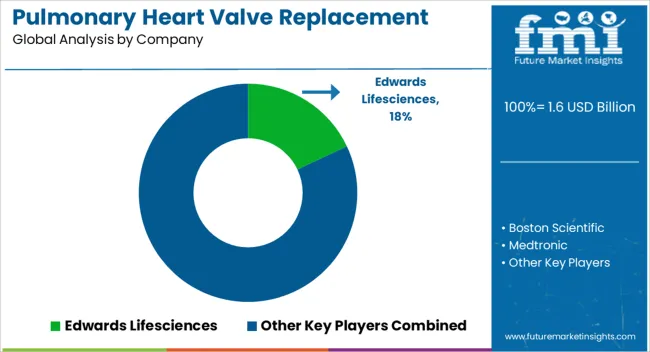
Some of the key players present in the global pulmonary heart valve replacement market are Edwards Lifesciences Corporation, Boston Scientific Corporation, Medtronic Inc., St. Jude Medical, Abbott laboratories Inc., Cryolife and others.
The report is a compilation of first-hand information, qualitative and quantitative assessment by industry analysts, inputs from industry experts and industry participants across the value chain. The report provides in-depth analysis of parent market trends, macroeconomic indicators and governing factors along with market attractiveness as per segments. The report also maps the qualitative impact of various market factors on market segments and geographies.
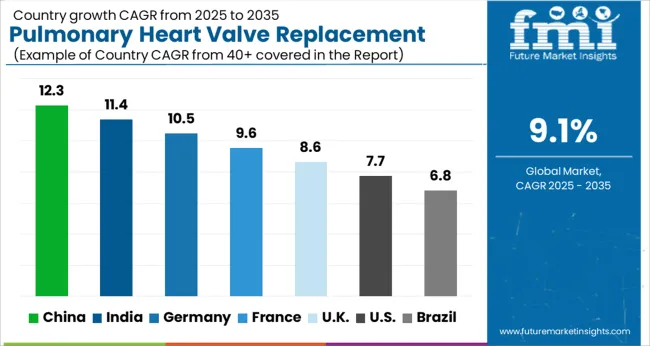
| Country | CAGR |
|---|---|
| China | 12.3% |
| India | 11.4% |
| Germany | 10.5% |
| France | 9.6% |
| UK | 8.6% |
| USA | 7.7% |
| Brazil | 6.8% |
The Pulmonary Heart Valve Replacement Market is expected to register a CAGR of 9.1% during the forecast period, exhibiting varied country level momentum. China leads with the highest CAGR of 12.3%, followed by India at 11.4%. Developed markets such as Germany, France, and the UK continue to expand steadily, while the USA is likely to grow at consistent rates. Brazil posts the lowest CAGR at 6.8%, yet still underscores a broadly positive trajectory for the global Pulmonary Heart Valve Replacement Market. In 2024, Germany held a dominant revenue in the Western Europe market and is expected to grow with a CAGR of 10.5%. The USA Pulmonary Heart Valve Replacement Market is estimated to be valued at USD 583.2 million in 2025 and is anticipated to reach a valuation of USD 1.2 billion by 2035. Sales are projected to rise at a CAGR of 7.7% over the forecast period between 2025 and 2035. While Japan and South Korea markets are estimated to be valued at USD 80.7 million and USD 41.3 million respectively in 2025.
| Item | Value |
|---|---|
| Quantitative Units | USD 1.6 Billion |
| Valve Type | Biological Valve and Mechanical Valve |
| Application Type | Pulmonary Valve Stenosis, Pulmonary Atresia, Pulmonary Valve Regurgitation, and Others |
| End User | Hospitals, Ambulatory Surgical Centers, Clinics, and Others |
| Regions Covered | North America, Europe, Asia-Pacific, Latin America, Middle East & Africa |
| Country Covered | United States, Canada, Germany, France, United Kingdom, China, Japan, India, Brazil, South Africa |
| Key Companies Profiled | Edwards Lifesciences, Boston Scientific, Medtronic, St. Jude Medical, Abbott, and Cryolife |
The global pulmonary heart valve replacement market is estimated to be valued at USD 1.6 billion in 2025.
The market size for the pulmonary heart valve replacement market is projected to reach USD 3.9 billion by 2035.
The pulmonary heart valve replacement market is expected to grow at a 9.1% CAGR between 2025 and 2035.
The key product types in pulmonary heart valve replacement market are biological valve and mechanical valve.
In terms of application type, pulmonary valve stenosis segment to command 42.8% share in the pulmonary heart valve replacement market in 2025.






Our Research Products

The "Full Research Suite" delivers actionable market intel, deep dives on markets or technologies, so clients act faster, cut risk, and unlock growth.

The Leaderboard benchmarks and ranks top vendors, classifying them as Established Leaders, Leading Challengers, or Disruptors & Challengers.

Locates where complements amplify value and substitutes erode it, forecasting net impact by horizon

We deliver granular, decision-grade intel: market sizing, 5-year forecasts, pricing, adoption, usage, revenue, and operational KPIs—plus competitor tracking, regulation, and value chains—across 60 countries broadly.

Spot the shifts before they hit your P&L. We track inflection points, adoption curves, pricing moves, and ecosystem plays to show where demand is heading, why it is changing, and what to do next across high-growth markets and disruptive tech

Real-time reads of user behavior. We track shifting priorities, perceptions of today’s and next-gen services, and provider experience, then pace how fast tech moves from trial to adoption, blending buyer, consumer, and channel inputs with social signals (#WhySwitch, #UX).

Partner with our analyst team to build a custom report designed around your business priorities. From analysing market trends to assessing competitors or crafting bespoke datasets, we tailor insights to your needs.
Supplier Intelligence
Discovery & Profiling
Capacity & Footprint
Performance & Risk
Compliance & Governance
Commercial Readiness
Who Supplies Whom
Scorecards & Shortlists
Playbooks & Docs
Category Intelligence
Definition & Scope
Demand & Use Cases
Cost Drivers
Market Structure
Supply Chain Map
Trade & Policy
Operating Norms
Deliverables
Buyer Intelligence
Account Basics
Spend & Scope
Procurement Model
Vendor Requirements
Terms & Policies
Entry Strategy
Pain Points & Triggers
Outputs
Pricing Analysis
Benchmarks
Trends
Should-Cost
Indexation
Landed Cost
Commercial Terms
Deliverables
Brand Analysis
Positioning & Value Prop
Share & Presence
Customer Evidence
Go-to-Market
Digital & Reputation
Compliance & Trust
KPIs & Gaps
Outputs
Full Research Suite comprises of:
Market outlook & trends analysis
Interviews & case studies
Strategic recommendations
Vendor profiles & capabilities analysis
5-year forecasts
8 regions and 60+ country-level data splits
Market segment data splits
12 months of continuous data updates
DELIVERED AS:
PDF EXCEL ONLINE
Pulmonary Fibrosis Biomarker Market Forecast Outlook 2025 to 2035
The Pulmonary Arterial Hypertension Treatment Market is segmented by Drug Class and Distribution Channel from 2025 to 2035
Global Pulmonary Function Testing Device Market Analysis – Size, Share & Forecast 2024-2034
Pulmonary Dilation Balloon Market
Cardiopulmonary Functional Testing Platform Market Size and Share Forecast Outlook 2025 to 2035
Cardiopulmonary Bypass System Market – Trends & Forecast 2025 to 2035
Bronchopulmonary Dysplasia Treatment Market Size and Share Forecast Outlook 2025 to 2035
Chronic Pulmonary Hypertension Treatment Market Analysis and Forecast by Drug Type, Route of Administration, Distribution Channel, Region through 2035
Idiopathic Pulmonary Fibrosis Management Market - Growth & Drug Advances 2025 to 2035
Progressive Pulmonary Fibrosis (PPF) Treatment Market - Growth & Innovations 2025 to 2035
Drug Resistant Pulmonary Tuberculosis Market
Chronic Obstructive Pulmonary Disease (COPD) Market Trends – Growth & Forecast 2023-2033
Heart Pump Device Market Forecast and Outlook 2025 to 2035
Heart Beat Sensor Market Size and Share Forecast Outlook 2025 to 2035
APAC Heart Health Functional Food Market Size and Share Forecast Outlook 2025 to 2035
Heart Closure Devices Market Size and Share Forecast Outlook 2025 to 2035
Heart Block Therapeutics Market Size and Share Forecast Outlook 2025 to 2035
Heart Beat Irregularity Detection Device Market Trends - Growth & Forecast 2025 to 2035
Heart Beat Monitor and Sensor Market
Heart Failure Testing Market

Thank you!
You will receive an email from our Business Development Manager. Please be sure to check your SPAM/JUNK folder too.
Chat With
MaRIA